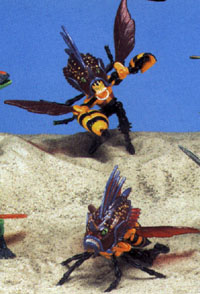 BEAST
WARS: TOY REVIEW
BEAST
WARS: TOY REVIEW 
His beast mode is about 180mm long from horn to tip of sting and he has a maximum wingspan of about 230mm. He’s about 100mm tall, depending on how you pose his legs or head.
Good points: unlike most insect-mode TFs, Aquasting can stand upon his own legs without his belly dragging the ground. Bad points: Aquasting doesn’t HAVE an insect mode. He’s half hornet, half lionfish. He’s neither insect nor fish. What he looks like is someone’s been trying to stuff a fish using a tiger and only gotten halfway. His wings have nice detailing, but that’s about it.
He has about 12 points of meaningful articulation, including legs, mouth, wings and back-section (abdomen, technically, though it’s hard to tell). He has two main gimmicks in this mode; he can fire out his stinger-missile (it actually fires QUITE far, one of Aquasting’s saving graces) and he can… um… head-butt. Press a button and his head dislocates, and he tries to stab someone with his ‘poison spines’. It’s probably the lamest gimmick to be seen on a Transformer since they brought out Transformers that weren’t able to transform.
Aquasting’s beast mode is truly UGLY, something that only
the Fuzors, in all of Transformerdom, can have said about them. He’s ugly,
ugly, ugly. This is probably one of the worst.
This is probably the only toy I’ll do this for: F, plain and simple.
Also known as a turkey fish or fire fish. The lion fish is any of several species of showy Indo-Pacific fish of the Scorpaenidae (scorpion fish) family. Lion fish are noted for their venomous fin spines which are capable of producing painful though seldomly fatal puncture wounds. They have enlarged pectoral fins and elongated dorsal spines. Each species also bears a particular pattern of bold, zebralike stripes.
When disturbed (for instance, if you had a lion fish a fish tank, and you pressed Injector up against the glass), the fish spreads and displays its fins and if further pressed (eg: you proceeded to transform Injector to robot mode), will present and attack with the dorsal spine ("Die, ye abomination!").
The most famous species is the Pterois volitans. It is striped with brown, red and white an grows to around 30 centimetres long.
Bibliography: Encyclopaedia Brittanica
Hornets
Members of the family Vespidae of social Hymenoptera; colonies
annual in cool climates, fertilised females (queeens) being the sole individuals
to overwinter, males and workers having perished.
Most Vespidae (which also includes wasps) construct a nest made of
"wasp-paper" or soil particles. They feed their larvae upon other insects,
portions of which they have previously masticated. The role of wasps and
hornets as predators is extremely beneficial. The Vespidae also feed on
meat, nectar and ripe fruits.
Bibliography: HYPP
Zoologie en ligne